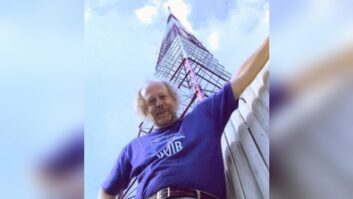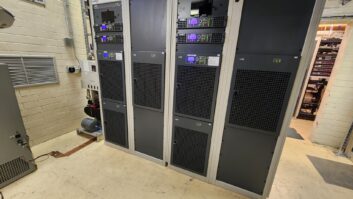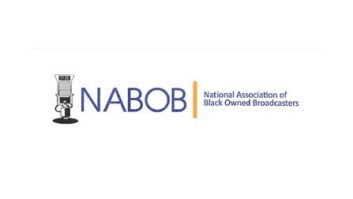Bonneville Phoenix moves its three-station operation
Dec 1, 2009 12:00 PM, By Gary Smith
The complexity of Bonneville Phoenix operation is apparent with just a short visit to the new facility. It would be next to impossible to operate as it is today had it remained in its downtown space.
Bonneville Phoenix recently moved its entire broadcast radio operation to a new location, consolidating three stations (KTAR-AM/FM and KPKX-FM) into a remodeled, 29,000-square-foot facility. Several factors contributed to the move, beginning with the acquisition of the second FM signal in 2006. This allowed us to split the KTAR brand into two operations: News/Talk 92.3 KTAR-FM and Sports 620 KTAR-AM. Consequently we saw a large increase in staff and the previous facility lacked adequate space and parking.
We considered an upgrade of the existing facility, but it would not solve the parking issue or add real estate. A second option was to purchase space in a nearby building to accommodate our music station, KPKX-FM 98.7 the Peak. This was a not feasible option from a financial perspective.

News/talk 92.3 KTAR-FM features a master control room and voice track studios.
A year-long evaluation led to the selection of our new location. Program management firm The Murray Company provided interior design, project management and construction services, encompassing the complete remodel job. The interior was gutted and built to its current configuration, utilizing 27,000 square feet of the rentable 29,000-square-foot space.
Facility layout and infrastructure
The conceptual design phase concluded with an intelligent layout plan. The goal was to ensure that the music operation received the same space and attention of the news/talk/sports operation. KPKX had little room to evolve in the old facility, so it was crucial to provide an environment where the station could establish a personality.
We decided to create talk and music wings. Each wing has its own rack room, studio suites, production facilities and workstations, as well as dedicated sales and office staff. Both technical operations have Harris PR&E Vistamax facility routing and studio networking at their respective cores.

The KTAR voice track studio. Operators have views of each studio in the KTAR cluster, ideal for visual cueing in a fast-paced environment.
Each rack room employs a Krone 110 punch block interface system from ADC to accommodate cross connects for various studio components. Quabbin Datamax single pair CAT-5e cables accommodate the core low-density wiring for rack-mounted equipment. Krone punch blocks are reliable and capable of supporting high-quality audio, AES3 audio, networking and control, even when mixed in the same 25-pair cable. The Krone 110 blocks are CAT-6-rated, high-band, network-quality punch blocks that minimize failures and establish patch bays for permanent and temporary connections. Datamax is the Harris cable of choice for console wiring and handles all but mic level applications with ease.
The more complex talk wing has the larger of the two rack rooms, featuring 19 Harris Integrator racks and one open-frame 23″ communications rack to house fiber for ISDN, optical Internet, IFBs and PRIs, while the music wing contains six racks. Both rack rooms are populated with a variety of satellite receivers (XDS, Starguide III, Max, Tiernan), studio workstation computers and infrastructure for various studio components (Telos 2101 Desktop Director, Comrex ISDN and POTS encoders). All computers for Broadcast Electronics Audiovault Flex automation delivery are KVM-extended to their respective studio destinations. This removes the computers from the operational areas, leaving only the monitor, keyboard and mouse.
The Vistamax studio networking systems for each wing reside in their respective rack rooms, with the music wing opting for the Vistamax Envoy system. Both Vistamax frames are wired to their associated punch block systems via Hitachi Power Sum 25-pair CAT-5e trunk cables terminated with Amphenol connectors. Studio trunk cables are done with Mohawk CAT-5e 25-pair cables along with a number of four-pair CAT-5e and CAT-6 home runs for specific equipment applications. All office telephony and networking is done with CAT-6 cabling. KVM extension is done with CAT-5 cabling since the CAT-6 twist introduces timing and phase error. This simple connection completes a large portion of the high-density wiring requirements and minimizing cable runs across the facility.
The Vistamax systems map signals from each station en route to the processing system. The first two stops in the air chain out of Vistamax are the EAS Interrupter unit and an AES/EBU splitter. The splitter sends the signals in two directions: One stream feeds a real-time Omnia processing and monitoring system, and the second stream hits an Air Tools 6100 profanity delay and ATI Digital DA before reaching the Moseley STL systems, stream encoders and Ilogger.
— continued on page 2
Bonneville Phoenix moves its three-station operation
Dec 1, 2009 12:00 PM, By Gary Smith
The complexity of Bonneville Phoenix operation is apparent with just a short visit to the new facility. It would be next to impossible to operate as it is today had it remained in its downtown space.
Bonneville Phoenix uses Moseley Starlink fixed 950kHz STL units with Starlink T1 backups. All radio STL units are installed on the roof to reduce RF in the rack rooms and minimize transmission line runs. The units are housed in a DDB Unlimited Insulated Outdoor Rack, with a 6,000 BTU side-mounted AC unit. The Starlinks are lightning protected with feed-thru polyphasors, mounted to the lower wall of the rack and bonded to the master ground system.
Two alternating, redundant Liebert air conditioning systems consistently cool each of the rack rooms at 65 degrees, providing the best trade-off between air conditioning expense and extended equipment life. The closed room system takes in air at floor level and exhausts high. Dual-redundant APC UPS systems provide electrical protection for the entire technical core.
General studio design

KPKX-FM (98.7 The Peak) is the music outlet for Bonneville Phoenix. This is the master control room.
Mohawk CAT-5e 350MHz 25-pair cables provide the backbone wiring for analog and digital audio from each studio, control room and voice booth, to and from the rack rooms. Cable trays are employed where required.
Double-pane �” glass is used in many of the studios and control rooms with 16″ walls, including �” plyboard layers and 1″ sound deadening panels to enhance acoustical isolation and reflectivity inside each room.
Harris PR&E custom furniture was installed throughout the facility for a consistent look and feel. Harris studio design representatives provided insight and design advice to make each room more ergonomically correct.
The furniture designs are similar in many rooms. For example, the three KTAR talk studios all feature two host and four guest positions, a separate voice booth and an isolated master control room. Each host has a Harris PR&E Stereomixer digital console with logic control, Vistamax Source Selectors, dropped keyboard trays and Vistamax intercoms. The intercom system is tied to the Stereomixer consoles to provide direct communication to the individual talent positions.

“The Flower” is a six-station cluster of workstations for Web content editors built from custom Harris PR&E furniture. The KTAR rack room is seen at right.
Individual headphone controls tied to a Harris PR&E 3�6 headphone distribution amplifier are built into the guest positions, with Electro-Voice RE-27ND microphones overhead. The on-air master control and voice booth studios feature the same setup for news and producer positions. In the music wing, custom furniture in the main KPKX air studio and production/backup air studio has two host and two guest positions, with much of the same built-in technology.
Every studio also utilizes Humanscale LCD monitor arms providing flexibility in positioning the computer monitors. This is critical for producers and technical directors who rely on visual cueing and require an unobstructed view of the talent.
The jewel of the furniture layout is a six-station work facility for Web content editors that we call the flower. This is a six-position cluster where the editors face each other while maintaining some privacy in the workspace. Each position has a view of one of two 48″ monitors showing alternating Web pages and TV news from around the nation. The Web content cluster is located in the newsroom so Web editors can immediately produce breaking news for the Web pages. Humanscale monitor arms used in the Web content cluster are also used throughout the newsroom.
Talk wing, on-air and production
Three studio suites are at the center of the KTAR-AM/FM operation: News/Talk 92.3 KTAR-FM programs news during morning drive from the news suite, also clearing games on the weekends, and programs both live and syndicated talk from mid-morning through the evening and early morning hours from the talk suite. Sports 620 KTAR-AM runs live, local morning and afternoon drive talk shows; clears live play-by-play and runs ESPN sports overnights from the sports suite. Each on-air operation has a dedicated on-air master control studio, talk studio and voice booth studio.
— continued on page 3
Bonneville Phoenix moves its three-station operation
Dec 1, 2009 12:00 PM, By Gary Smith
The complexity of Bonneville Phoenix operation is apparent with just a short visit to the new facility. It would be next to impossible to operate as it is today had it remained in its downtown space.
Technology is similar across the three suites. Each on-air studio includes Harris custom furniture with a host and producer position; the host has a Stereomixer digital console with RE-27 microphone for on-air/production use, and a technical director is situated behind a Harris PR&E RMX Digital console with 28 input channels.
The RMX Digital is an ideal console for talk and sports programming. The technical directors often simultaneously bring in multiple remote sources. This is especially true for Sports 620, the flagship station for Arizona Diamondbacks baseball, Arizona Cardinals football, Phoenix Suns basketball and Arizona State University sports. The RMX Digital is a powerful, programmable console that offers instantly changeable mix buses so technical directors can juggle multiple remotes from various arenas, restaurants or other remote locations; and create mix scenarios on the fly in challenging situations.

Each workstation in the newsroom is used to produce news clips for KTAR-AM-FM and KPKX-FM.
Remotes are brought in a number of ways, with 8kHz equalized program loops from around the valley, including talent homes, Metro Traffic, Chase Field, United Airways Arena and a KTAR studio located on the Chase Field Plaza. Four Marti STL receivers are located on two nearby mountains to pick up and backhaul audio to the studios for the news department, sports department and a traffic airplane. The Martis are also regularly utilized for remote broadcasts in conjunction with a Comrex Access, with no send latency and minimal latency on the IFB return.
On-air hosts, producers and news reporters working out of the news wedge studios all rely heavily on Wireready for audio editing and news production. The Wireready system provides integrated text and audio for news and sports reporters. Stereomixer allows hosts and reporters to bring in Wireready sources, produce content and route that content to the RMX Digital for play to air; and subsequently onto the Vistamax networking system for distribution to other studios, if desired.
Operators can divorce the Stereomixer from the RMX Digital via a simple source selector if the host or reporter prefers to go direct to air from their positions. Similarly, the Stereomixer can separate from the RMXdigital for production purposes during breaks or downtime. Stereomixer consoles are also used in two Pro Tools-equipped production studios (a third, production B, uses a Harris Netwave console), the newsroom, a Tivo recording studio and an imaging studio.
Other equipment present in the on-air and production studios include Air Tools 6200 dual-channel microphone processors, a Telos 2101 Desktop Director, Mackie HR824 powered studio monitors, Mackie HRS120 studio subwoofers, Marantz compact flash recorders, and Tascam 1RU professional CD players. Harris World Feed Panels in each studio also provide additional inputs and outputs for TV stations or other external media productions.
The Pro Tools-equipped imaging studio sets the sound for the station, using specialized equipment to enhance the talent’s voice during breaking news. The imaging studio is an exact replica of production A and production C, with the exception of a Neumann microphone and a Manley voice processor instead of the usual Electro-Voice/Air Tools system.
Talk wing, news and Web

The lobby provides entry to the news/talk wing on the left and the music wing to the right.
The complexity of the KTAR-AM/FM operation extends far beyond the on-air and production elements.
News/Talk 92.3 KTAR-FM is a rapid-pace operation that alternates between day parts, airing news in the morning and talk in the afternoon. The news team is comprised of three on-air talents and a technical director. The talk talent requires at least 30 minutes of studio preparation prior to going to air. Separate morning and afternoon studios minimize the confusion and provide a seamless air transition.
The non-stop action between these two suites � not to mention the third studio suite for Sports 620 KTAR-AM � partially motivated the decision to establish a KTAR Command Center. The Command Center overlooks all three studio suites. It is home to the news editor and news managing editor, both of whom have a commanding view of everything happening in the various studios.
More importantly, the Command Center is the bandleader for the newsroom. The editors control the dispatching of news reporters and communicate with the sports department. The Command Center is equipped with most of the technology found in the on-air and production studios, and can send and receive audio to multiple studios and workstations over Vistamax.
— continued on page 4
Bonneville Phoenix moves its three-station operation
Dec 1, 2009 12:00 PM, By Gary Smith
The complexity of Bonneville Phoenix operation is apparent with just a short visit to the new facility. It would be next to impossible to operate as it is today had it remained in its downtown space.
Newsroom reporters, content editors and command center editors communicate using Vistamax intercom stations, present at all 16 workstations in the news and sports rooms. Reporters/editors at these workstations can also communicate with any of the control rooms in the three studio suites. News and sports reporter workstations are also equipped with Stereomixers, source selectors and Wireready stations to produce content for immediate or future broadcasts.
There are eight workstation positions for news reporters and six for sports reporters in the newsroom. While positions 1-6 for the news reporters are specifically for editing/reporting, positions 7 and 8 are reserved for Tivo recording. KTAR-AM/FM has four dual-channel Tivo systems recording as many as eight TV programs at any time to capture news, current events and entertainment shows that can potentially be used for audio clips. Operators pull audio bits through the course of the day, using a Stereomixer coupled with Adobe Audition to produce broadcast clips.
Behind the newsroom is a curved wall with three positions for Web page code writers and a graphic artist. Web content is updated throughout the day, including video received from remote broadcasts. The studios are also designed and ready for video. Camera angles are set in two directions: Hosts are framed with the station logo behind them and guests are framed between the hosts, and the command center is visible in the background.
Music wing
The music wing seems comparatively simple in contrast to the talk wing. Most of the rack room and studio infrastructure is similar, but there is one difference crucial to the on-air and production operation: the Harris Netwave console.
The NetWave is ideal for the music operation because KPKX 98.7 The Peak talent operates the console while on-air. There are limited remote needs and less on-air complexity. The Netwave lends itself well to a music operation because it provides access to multiple sources, but is not complicated to operate while focusing on the show.
The Netwave frame allows for mapping through the Vistamax Frame and for access to external sources, or to route audio to other parts of the facility. Two routable module panels were added to the Netwave consoles, providing four source-selection inputs as part of each console. This quadruples the amount of inputs of our previous one-input system, and is more than adequate for a music operation.
A large conference room near the KPKX studios is available for special on-air events such as visiting bands, radiothons or news conferences. This large room has a movable wall and is ideal for a 12-to-15 telephone bank; shows can be done live from this room using a World Feed Panel routed to the Vistamax Envoy studio networking system.
The Harris World Feed Panel is essentially a remote from inside the building, and is treated the same way as an ISDN or other external feed when called as a source on a Netwave or RMX Digital. Its capacity as a multiple I/O board is very handy for giving real-time program feeds at a professional mic or line level to television crews, musicians and even full bands with multiple instruments.
The complexity of Bonneville Phoenix operation is apparent with just a short visit to the new facility. It would be next to impossible to operate as we are today had we decided to remain downtown. The new space is serving us well in the early days, and we expect to discover new technical possibilities moving forward.
Equipment List
Air Tools 6100
Broadcast Electronics Audiovault Flex
Comrex Access
Electro-Voice RE-27ND
Fostex RM-1
Harris Control Turrets
Harris Integrator HRK, furniture, PR&E 3X6 headphone amp, Harris PR&&E Netwave 16, PR&&E RMX Digital, PR&&E Stereo Mixer Digital, PR&&E Vistamax Envoy, Vistamax intercom, World Feed Panel
Humanscale LCD monitor arms
Krone blocks
Mackie HR824, HRS120
Marantz PMD570 compact flash recorder
Mohawk wire and cable
Moseley Starlink
Symetrix 6200
Tascam CD-01U Pro 1RU CD player
Telos 2101
Yamaha Active HS50M
Smith is director of engineering, Bonneville Phoenix.












